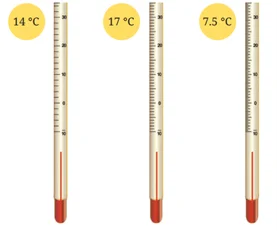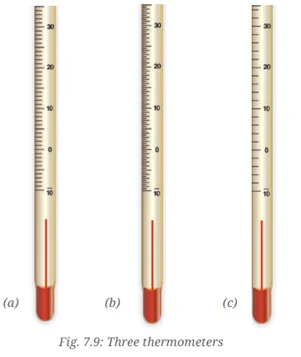📘 NCERT Intext Questions — Temperature and its Measurement (Class 6)
🤒 Q.1. Can it always be correctly judged that a person has fever, only by touching the person?
(Page No. 123)
Show Answer
If a thermometer shows 38°C, the person has a fever because the normal body temperature is 37°C (98.6°F).
👶🌡️ Q.2. Do small children generally have slightly higher body temperatures as compared to adults?
(Page No. 128)
Show Answer
A healthy child may have a body temperature of about 37.2°C, while an adult’s temperature may be 36.8°C — both are normal.
👴🌡️ Q.3. Do old people, even when healthy, generally have lower body temperatures than young adults?
(Page No. 128)
Show Answer
• A healthy young adult may have a temperature of about 37°C (98.6°F).
• A healthy old person may have around 36.5°C (97.7°F) — which is still normal for their age.
🌡️ Q.4. Can a clinical thermometer be used for measuring the temperature of boiling water? Or for measuring the temperature of ice? (Page No. 129)
Show Answer
🧪 Q.5. How can we measure temperatures beyond the range of a clinical thermometer? (Page No. 129)
Show Answer
• Boiling water → measured using a laboratory thermometer (range up to 110°C)
• Freezing mixture → also measured using the same thermometer
Let us enhance our learning
🤒 Q.1. The normal temperature of a healthy human being is close to:
Show Answer
🌍 Q.2. 37°C is the same temperature as:
Show Answer
°F = (9/5 × °C) + 32
So, (9/5 × 37) + 32 = 98.6°F ✅
✏️ Q.3. Fill in the blanks:
Show Answer
✅ Answer: Temperature
✅ Answer: Clinical
✅ Answer: Celsius
🧪 Q.4. The range of a laboratory thermometer is usually:
Show Answer
🌡️ Q.5. Four students used a laboratory thermometer to measure the temperature of water as shown in the diagram below. Who do you think followed the correct way of measuring temperature?
Show Answer

(Diagram showing Students 1–4 using the thermometer)
A laboratory thermometer should be used correctly by following these steps 👇
2️⃣ It should be completely dipped in water so that the bulb is fully surrounded by the liquid.
3️⃣ The thermometer should be kept vertical (upright).
4️⃣ The temperature should be read at eye level.
👉 In the image, Student 3 followed all these steps correctly!
🌡️ Q.6. Colour the red column on the drawings of thermometers according to the temperatures written beside each thermometer. (14°C, 17°C, and 7.5°C)
Show Answer

(Thermometer diagram for students to color.)
🟥 Colour the red column slightly above the 10°C mark — nearly halfway between 10°C and 15°C.
🟥 Colour the red column a little above the 15°C mark, closer to 17°C on the scale.
🟥 Colour the red column between the 5°C and 10°C marks, exactly at the middle.
The red column in a thermometer shows the mercury level, which rises when temperature increases and falls when it decreases.
By coloring it correctly, you visually represent the measured temperature on each thermometer.
🌡️ Q.7. Observe the part of the thermometer shown in the diagram and answer the following questions:
Show Answer

(Thermometer image showing mercury level at 26°C.)
(The red column of mercury stops just below the 30°C mark.)
A laboratory thermometer generally has a range of –10°C to 110°C, and each small marking represents 1°C.
The mercury level rises or falls depending on the temperature of the liquid it is placed in.
🧪🌡️ Q.8. A laboratory thermometer is not used to measure our body temperature. Give a reason.
Show Answer
If we try to use a laboratory thermometer for a person’s body, the reading will change instantly as soon as we take it out — making it useless for medical use.
🤒 Q.9. Vaishnavi has not gone to school as she is ill. Her mother has kept a record of her body temperature for three days as shown in the table below 👇
Show Answer
| Temperature at | 7 am | 10 am | 1 pm | 4 pm | 7 pm | 10 pm |
|---|---|---|---|---|---|---|
| Day 1 | 38.0°C | 37.8°C | 38.0°C | 38.0°C | 40.0°C | 39.0°C |
| Day 2 | 38.6°C | 38.8°C | 39.0°C | 39.0°C | 39.0°C | 38.0°C |
| Day 3 | 37.6°C | 37.4°C | 37.2°C | 37.0°C | 36.8°C | 36.6°C |
(Table: Body Temperature Record of Vaishnavi)
• Normal body temperature = 37°C (98.6°F)
• On Days 1 and 2, her temperature was above 38°C → Fever 🤒
• On Day 3, it dropped below 37.6°C → Normal 😊
🌡️ Q.10. If you have to measure the temperature 22.5°C, which of the following three thermometers will you use? (Refer to diagram below 👇)
Show Answer

(Diagram showing three thermometers labeled a, b, and c.)
🧪 Thermometers with smaller least counts (like 0.5°C or 0.1°C) give more accurate readings!
🌡️ Q.11. The temperature shown by the thermometer in the diagram is:
Show Answer

(Diagram showing thermometer reading at 27.5°C.)
• Each small marking represents 0.5°C.
• Therefore, halfway between 25°C and 30°C = 27.5°C ✅
That’s why careful observation is needed for an accurate reading!
🧪 Q.12. A laboratory thermometer has 50 divisions between 0°C and 100°C. What does each division of this thermometer measure?
Show Answer
Total divisions = 50
👉 Value of each division = 100 ÷ 50 = 2°C
Each small marking (division) on a thermometer scale represents a specific temperature difference.
Here, every 2°C rise or fall in temperature will move the mercury column by one division.
🌡️ Q.13. Draw the scale of a thermometer in which the smallest division reads 0.5°C. You may draw only the portion between 10°C and 20°C.
Show Answer

(Thermometer scale drawing showing 10°C–20°C with 0.5°C divisions.)
2️⃣ Mark 10°C at the lower end and 20°C at the upper end.
3️⃣ Divide the space between 10°C and 20°C into 20 equal parts — because each division = 0.5°C.
4️⃣ Label every second line (10.5°C, 11°C, 11.5°C... up to 20°C).
5️⃣ Draw a red mercury column anywhere between two markings to show a temperature reading.
• Difference between 10°C and 20°C = 10°C
• Each division = 0.5°C
• Number of divisions needed = 10 ÷ 0.5 = 20 divisions
✅ Therefore, between 10°C and 20°C, there should be 20 small markings, each representing 0.5°C.
For example, thermometers with 0.1°C divisions are used in scientific laboratories for precise experiments!
🤒 Q.14. Neha tells you that she has a fever of 101 degrees. Does she mean it on the Celsius scale or the Fahrenheit scale?
Show Answer
• The normal body temperature of a healthy person is 98.6°F or 37°C.
• A temperature of 101°F is slightly higher than normal — showing that Neha has a fever.
• If it were 101°C, it would be extremely high and impossible for the human body to survive!
👉 Therefore, Neha’s 101 degrees refers to the Fahrenheit scale.
📚 Explore More Class 6 Chapters (Questions and Answers)
🌡️ FAQs — Temperature & Its Measurement (Class 6)
1. What is temperature?
Temperature shows how hot or cold a body or substance is. It is measured in degrees Celsius (°C) using a thermometer.
2. What is the normal body temperature of a healthy person?
A healthy person’s normal body temperature is about 37°C (98.6°F). Small variations are normal through the day.
3. Clinical vs laboratory thermometer — what’s the difference?
Clinical thermometers measure human body temperature (≈35–42°C) and have a kink to trap mercury. Laboratory thermometers have a wider range (e.g., −10 to 110°C) and no kink.
4. Can you use a clinical thermometer for boiling water or ice?
No. Clinical thermometers are limited to body range and can break if used for extreme temperatures like 0°C or 100°C. Use a laboratory or digital thermometer instead.
5. What is the least count of a thermometer?
The least count is the smallest temperature difference the thermometer can show (for example, 0.5°C, 1°C, or 2°C). A smaller least count gives more precise readings.
6. How do you read a thermometer correctly?
Hold the thermometer vertically, ensure the bulb is fully in the liquid (or under the tongue for clinical use), and read the scale at eye level to avoid parallax error.
7. Why should the thermometer bulb not touch the beaker’s bottom?
Touching the bottom transfers heat from the container, not just the liquid, causing an incorrect (usually higher) reading.
8. How to measure temperatures needing half-degree accuracy (e.g., 22.5°C)?
Use a thermometer whose scale has a least count of 0.5°C or finer; otherwise you cannot reliably read 22.5°C.
9. What precautions should be taken while using thermometers at home?
Keep it clean, do not use a clinical thermometer for boiling liquids, avoid sudden temperature shocks, and store it safely to prevent breakage.
10. Why does body temperature vary during the day?
Body temperature follows a daily rhythm — typically lower in the morning and higher in the evening due to metabolic activity and physical activity levels.
